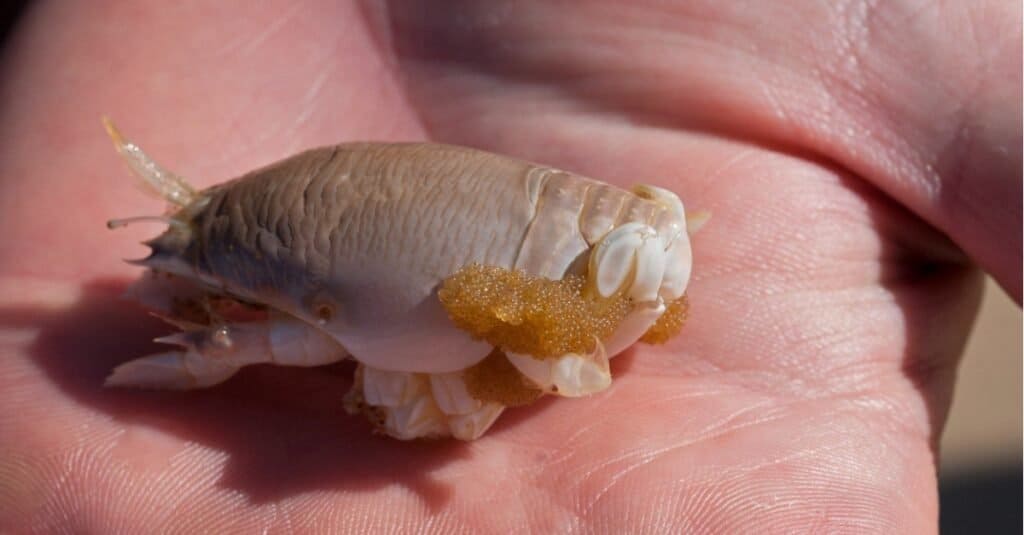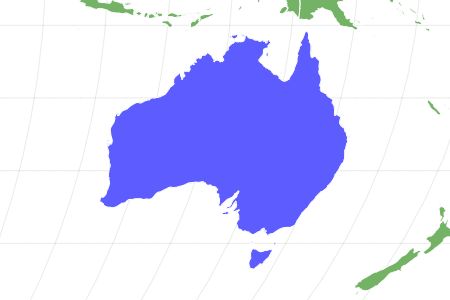Mole Crab (Sand Flea)
Emerita analoga, Emerita analoga, and others
They eat jellyfish tentacles
Advertisement
Mole Crab (Sand Flea) Facts
- Prey
- Plankton, tiny organisms
- Name Of Young
- Larvae
- Fun Fact
- They eat jellyfish tentacles
- Biggest Threat
- Predation and ocean acidification
- Most Distinctive Feature
- Barrel-shaped bodies
- Other Name(s)
- Sand flea
- Average Spawn Size
- up to 45,000
- Habitat
- Tropical and subtropical beaches
- Predators
- Barred surfperch, seabirds
- Diet
- Herbivore
- Lifestyle
- Nocturnal
- Type
- Crustacean
- Common Name
- Mole crab
- Special Features
- Telson ("digger")
- Number Of Species
- 10
- Location
- North America, South America, Africa, Australia, Asia
Mole Crab (Sand Flea) Physical Characteristics
- Color
- Sandy
- Skin Type
- Exoskeleton
- Lifespan
- 2 to 3 years
- Length
- 0.3 to 2 inches
- Age of Sexual Maturity
- 1 year
View all of the Mole Crab (Sand Flea) images!
“They stick slightly out of the sand and lift their antennae, creating a small V-shape wave as the water recedes.“
Summary
The mole crab, or sand flea, is a decapod crustacean that lives in tropical or subtropical regions. They burrow in the wet sand near the beach wave-breaking zone, creating tiny V-shaped ripples with their raised antennae. These barrel-shaped crabs are perfectly suited to their environment, filtering organisms from the water and even feeding on deadly tentacles. Discover all the fascinating facts about the mole crab, including where they live, what they eat, and how they behave.
Mole Crab Species, Types, and Scientific Name
The mole crab (Emerita) belongs to the arthropod phylum in the Malacostraca class. Arthropods are invertebrate animals with exoskeletons, and the Malacostraca includes over 40,000 crustaceans. It’s included in the Decapoda order, along with crabs, lobsters, crayfish, shrimp, and prawns. Emerita is a small genus in the Hippidae family, encompassing the mole crabs or sand crabs.
There are ten recognized mole crab species:
- Emerita analoga – western North America and western South America
- Emerita austroafricana – southeastern Africa and Madagascar
- Emerita benedicti – Gulf of Mexico
- Emerita brasiliensis – southeastern Brazil and northeastern Brazil
- Emerita emeritus – south Asia and southeast Asia
- Emerita holthuisi – western India, Persian Gulf, and Red Sea
- Emerita karachiensis – Pakistan
- Emerita portoricensis – Caribbean Sea
- Emerita rathbunae – western Central America
- Emerita talpoida – eastern North America
- Emerita asiatica – southern India
Appearance: How to Identify Mole Crabs
Mole crabs are small crustaceans with barrel-shaped bodies, measuring 0.3 to 2 inches long, no bigger than a human thumb. Females are typically much bigger than males and contain bright orange egg masses on their underbellies. Because adults are sand-colored, they blend in well with their environment. They have tough exoskeletons with five sets of legs on their undersides, which they use to move through the water, dig in the sand, and move backward. However, they can’t walk on dry sand. They also have feathery antennae, which help them eat, and gills to survive in the water (like other crustaceans). Located on their underbelly is the “digger,” which protects their eggs, initiates digging, and anchors them in the sand.

Female mole crabs are typically much bigger than males and contain bright orange egg masses on their underbellies.
©iStock.com/jess311
Behavior
The sand flea is an excellent burrower, covering itself in the sand in 1.5 seconds. They burrow tail first and stay in the wave-breaking zone, changing position as the tide ebbs and flows. In the spring, they form colonies in the “Swash zone,” where the waves run up the beach, and begin mating. They stick slightly out of the sand and lift their antennae, creating a small V-shape ripple as the water recedes.
Habitat: Where to Find Mole Crabs
The mole crab genus has a wide range but primarily inhabits tropical and subtropical beaches on five continents, including North America, South America, Africa, Australia, and Asia. Individual species are restricted to specific regions and rarely overlap. They are found on both coasts of the United States, western Central America, South America, along Africa’s Atlantic Coast, and across Indo-Pacific Asia. Look for them in the wet sand at the water’s edge at many beaches. Look for the distinctive V-shape waves as the water recedes; they are typically in sand flea colonies.
Diet: What Do Mole Crabs Eat?
Mole crabs eat plankton and other tiny ocean organisms. When burrowing in the sand, they stick their antennae out and filter detritus (dead organic material) from the swash. They use their feathery antennae to funnel particles into their mouths. These creatures are the perfect example of an animal adapting to its environment. Amazingly, this crustacean can also eat deadly Portuguese man-o’ war tentacles.
Reproduction
Their reproductive system runs from February through October but will vary by region. Females produce one clutch every month, and each clutch contains up to 45,000 eggs! The mass is bright orange, and the eggs take around one month to develop, turning brown shortly before hatching. They hatch during high tide and begin their life floating through the sea as larvae. They are juveniles three to six months later when they wash up on shore and join older mole crabs buried in the sand. These arthropods can reproduce within their first year and have a short lifespan of only two to three years.
What Threatens the Mole Crab?
Their main predators are fish, birds, and humans. Mole crabs are an essential food source for the barred surfperch on the eastern Pacific Ocean, and seabirds are a threat across their range. Fishermen use sand fleas as bait, digging them up and storing them for later. You can also purchase these crabs from many bait shops. Like other shelled organisms, mole crabs are susceptible to the threat of ocean acidification, a chemical change in the water tied to carbon dioxide levels.
Related Animals:
View all 164 animals that start with MMole Crab (Sand Flea) FAQs (Frequently Asked Questions)
Can mole crabs hurt you?
Mole crabs are harmless to humans. They do not bite, pinch, or scratch. They can’t even walk, and spend much of their lives burrowed in the sand.
How do humans use mole crabs?
Humans use mole crabs as fish bait. You can often find them in bait shops in the United States.
How big can mole crabs get?
Mole crabs are small crustaceans with barrel-shaped bodies, measuring 0.3 to 2 inches long, no bigger than a human thumb.
Where do mole crabs live?
The mole crab genus has a wide range but primarily inhabits tropical and subtropical beaches on five continents, including North America, South America, Africa, Australia, and Asia.
What do mole crabs eat?
Mole crabs eat plankton and other tiny ocean organisms. Amazingly, this crustacean can also eat deadly Portuguese man-o’ war tentacles.
What eats mole crabs?
Mole crabs are an essential food source for the barred surfperch in the eastern Pacific Ocean, and seabirds are a threat across their range.
What threatens the mole crab?
Like other shelled organisms, mole crabs are susceptible to the threat of ocean acidification, a chemical change in the water tied to carbon dioxide levels.
Thank you for reading! Have some feedback for us? Contact the AZ Animals editorial team.
Sources
- Fishing Destin Guide, Available here: http://fishingdestinguide.com/baitSANDFLEAS.html
- Chicago Journals, Available here: https://www.journals.uchicago.edu/doi/abs/10.2307/1540910
- Web Archive, Available here: https://web.archive.org/web
- Loyno.edu, Available here: https://lucec.loyno.edu/natural-history-writings/mole-crabs

















